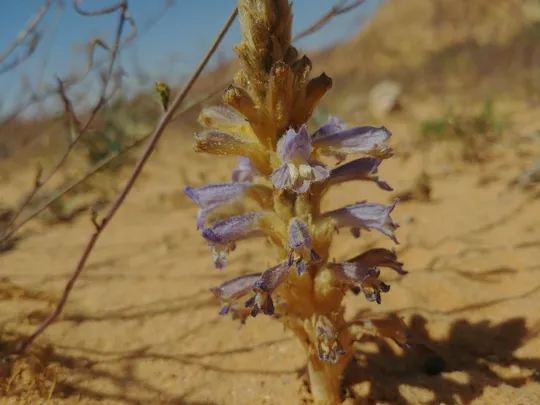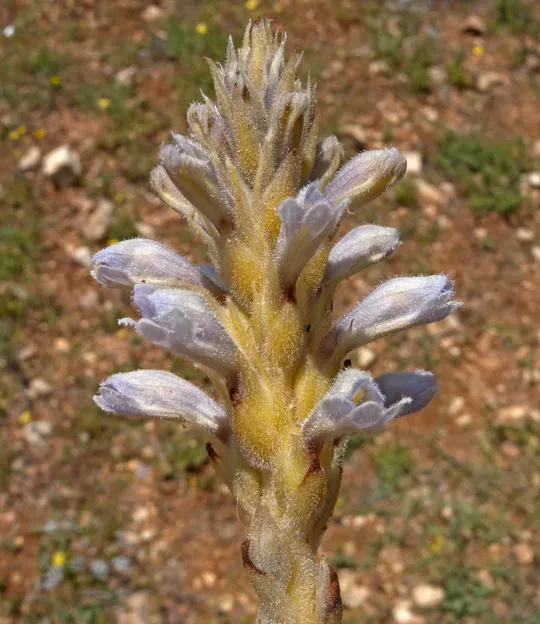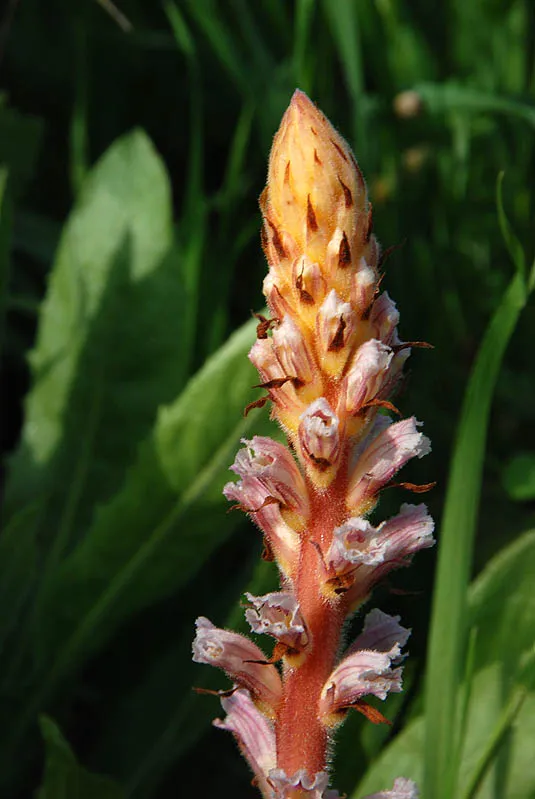Palestine Broomrape
Orobanche palaestina
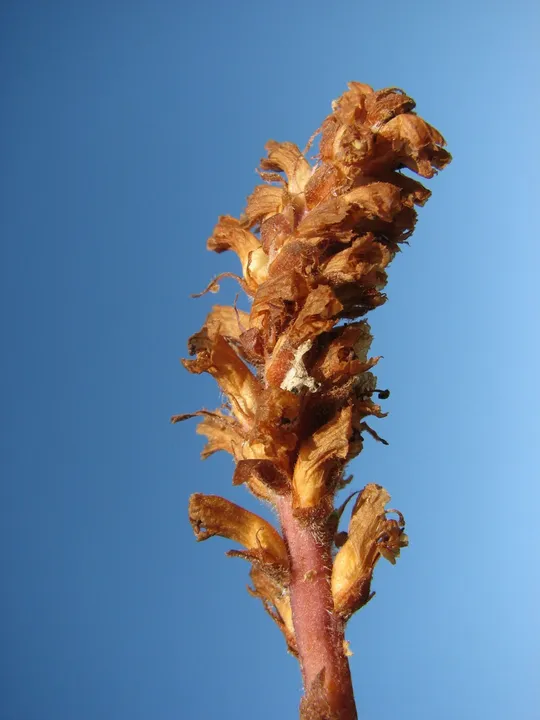
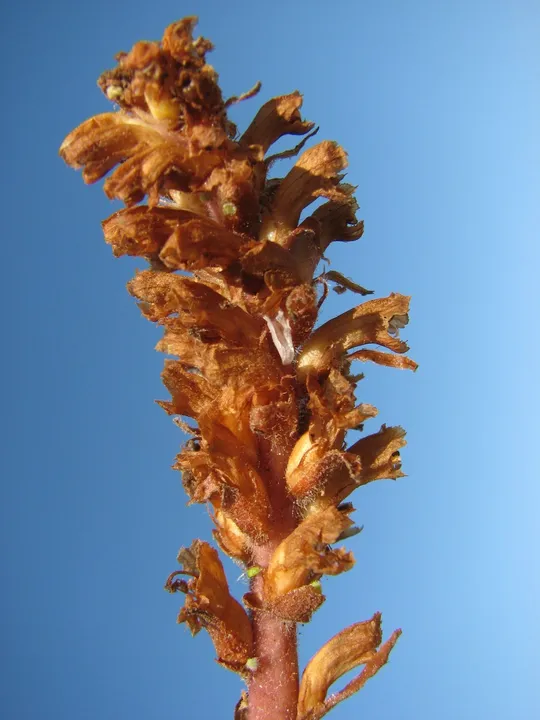
Orobanche palaestina is currently found in five regions: the Golan Heights,
Upper Galilee, Lower Galilee, Carmel and the Judean Mountains. The total number
of known sites is six. In the Golan Heights, it was observed on the Banias Plateau.
In the Upper Galilee, it was first collected in 1926 in the Kziv Stream but has
not been found there since. Recently (2010), however, a few specimens were
observed on the slopes of the Naftali Mountains below Misgav Am (not marked on
the map). In the Lower Galilee, O. palaestina
was identified as a new species for the region near Ka’abiyye during the 1997rare
plant survey, but disappeared from Kiryat Amal. In the Carmel it disappeared
from the Haifa area but it was located on Hill 108 opposite against Tel Kashish.
In the Judean Mountains it was recorded in Tsur Hadassa and in the Kobe ruins;
until 1982 it was also found in in Givat Ram in Jerusalem, although it has not
been found there since. In the literature the species is noted from many other
regions in Israel that include the Sharon, Pleshet, Samaria and the northern
Negev, but there is no verification from the field despite many years of
searching.
Terra rossa soil in deep soil patches of open
woodland and fallow land in montane habitats. Orobanche
palaestina also grows on the edges of fields and in Quercus ithaburensis forests on dark rendzina soil. In the literature, the
habitat is described as "fallow land on heavy soils."
Orobanche palaestina
belongs to the Orobanche group that has an abundant inflorescence and
a relatively large flower with wide divergent corolla petals, which can be termed
the "Orobanche kurdica group". Other Orobanche
species belonging to this group in Israel include O. crenata, O. hermonis and O. pubescens.
All the species in this group have an unbranched flower stem and the flower lacks
lateral bracteoles on the large bract at its base. The species in the group in
Israel can be differentiated by the flower color and its habitat: O.
crenata has a white
flower, O. pubescens has a bright
purple-pink flower, O. hermonis
has a cognac-loam colored flower and O. palaestina has a yellowish-cream colored
flower. The species in the group (except O.
crenata) are characteristic of montane areas throughout
the Middle East and the Caucasus, and our species is the southernmost one.
The Orobanche species are serious
agricultural pests to certain crops: the most common species and the worst pest
that causes serious damage to crops is O. crenata,
which attaches to and threatens winter vegetable mostly in fields on alluvial
soils in valleys. In recent years, two additional species invaded irrigated
agricultural fields in Israel.
·
The number of Orobanche
palaestina sites has decreased in all the
regions in which it was observed or collected, particularly in the Judean Mountains.
However, due to its rarity the information regarding regions and sites is
lacking. It is also unclear if the regions and other sites, from which it was recorded
in the past, were cases of mistaken identification or evidence of extinction.
·
The biology of the species is not known; therefore, the
cause of its great rarity is unclear, as the plants to which it attaches are
abundantly available.
·
Its local status is equivalent to its global status,
since the species is endemic only to Israel and Lebanon.
A thorough field survey should be conducted
to locate Orobanche palaestina populations, and to obtain more accurate
determination of growth sites and population sizes. At least one of the
populations should be monitored (e.g. the Jerusalem Hills population) and its
taxonomy and genetics studied. The fact that the plant is a parasite does not
reduce the importance of its conservation, because this particular species does
not attack or damage crops.
Orobanche palaestina is a sub-endemic species that grows only in Israel and
a bit into Lebanon. Tristram recorded the species from Moab in Jordan, but this
data is extremely improbable. Feinbrun, in the Flora Palaestina, recorded O.
palaestina only from Israel, but did not specifically
term it an endemic species, as the taxon is noted (with the synonym O.
grisebachii) from Lebanon as well and documented in the Herbarium (Post,
1932). Thus, we decided, unlike the Flora and the Conspectum, that the species
is endemic not only to Israel, but to Israel and Lebanon.
Orobanche palaestina is
a parasite on wild plants, rare in nature, which grows in Mediterranean regions
of Israel and is endemic to Israel and Lebanon. Additional surveys are required
to obtain more information and to provide a more
reliable assessment of the threats facing the species and the necessary conservation
steps to be taken.
Current Occupancy Map
| 1000 squre meter pixel | 5000 squre meter pixel | 10000 squre meter pixel | |
|---|---|---|---|
| number of observations | 0 | 0 | 0 |
| in total pixels | 0 | 0 | 0 |
| Family | Orobanchaceae |
| Classification | On the endangered species list |
| Ecosystem | Mediterranean |
| Chorotype | Eastern Mediterranean |
| Conservation Site | Sansan Nature Reserve near Tsur Hadassa |
| Rarity |
1
3
6
|
|---|---|
| Vulnerability |
0
2
4
|
| Attractiveness |
0
1
4
|
| Endemism |
0
2
4
|
| Red number |
1
4.2
10
|
| Peripherality | N |
| IUCN category | DD EW EX LC CR EN VU NT |
| Threat Definition according to the red book | Endangered |
 Based on:
Based on:
